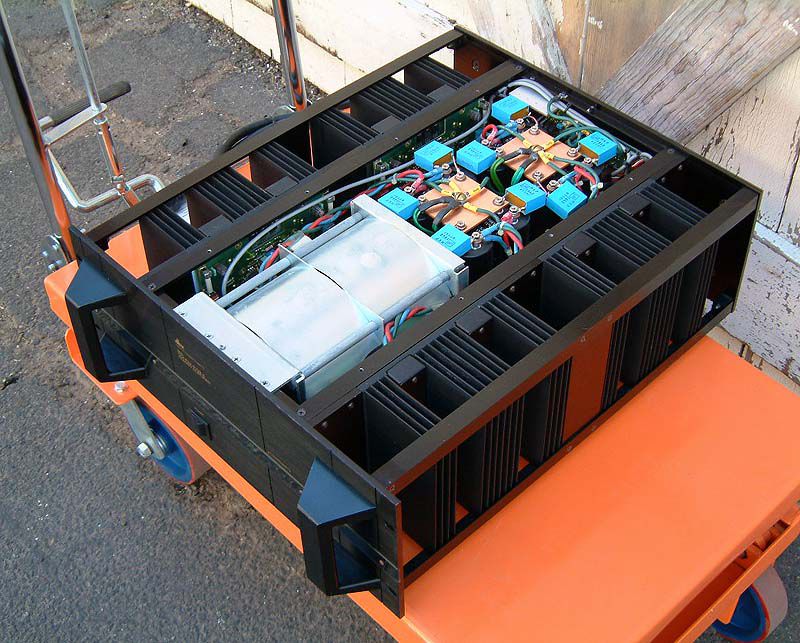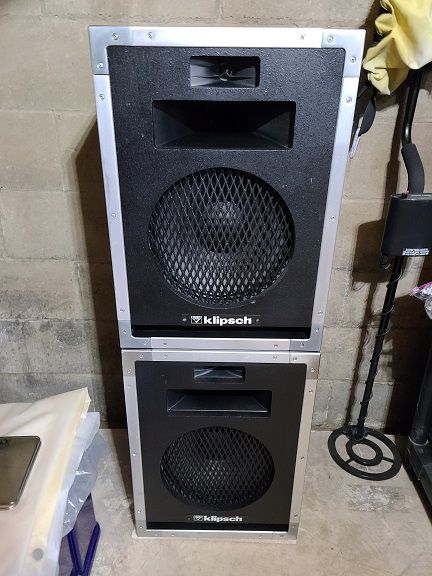-
Posts
7707 -
Joined
-
Last visited
Content Type
Forums
Events
Gallery
Everything posted by Frzninvt
-
I did own an original DBX 3BX and never did have a chance to compare it directly to the Pioneer EX-9000. From my understanding the DBX units use a mono triggered VCA whereas the Pioneer unit has stereo triggered VCA's which some people think was the correct way to do it. The Pioneer also has independently adjustable bands for HF, MF, LF which the DBX does not have. It also has two processing curves hard and soft that the DBX does not have. The Pioneer can usually be had cheap enough to experiment with. For some reason the DBX processors have skyrocketed in price in past couple of years perhaps due to the resurgence of vinyl. I have compared the Pioneer EX 9000 to the last iteration of the DBX 3BX the 3BX-DS and found that I definately preferred the DBX unit. The 3BX-DS is far more flexible than the original 3BX as it can compress, expand, and has three active bands of impact restoration. Additionally it has an ambience function that can add or subtract from the L or R channel that can come in handy on some recordings. The compression feature has become more useful since most recent recordings are way oversaturated allowing the user to tame that some. The 3BX-DS also performs as a noise gate. If you use mostly analog sources like a reel to reel or turntable I would recommend the more aggressive processing offered in the 3BX-III expander. The flagship DBX 5BX-DS is a 5-band computer controlled unit with 5 independent bands of impact restoration but this unit is really a compressor and not an upward expander like the 3BX-DS. The only upward expansion comes from the impact restoration circuits. I have access to user manuals and cut sheets for these units if you feel like doing any reading. A killer array is to purchase a DBX 400XG Program Route Selector and use a DBX 3BX-DS, 120X-DS, and lastly the DBX 14/10 14 band 2/3 octave computer controlled equalizer. Going this route allows you to pick and choose what processor you want active or none at all. It even have a special loop for a 224X-DS Type II Noise Reduction unit.
-
It may not be weighted the same as the original and won't perform the same. Proceed with caution.
-

85' HWL in NW Indiana for $900 These are GORGEOUS!!
Frzninvt replied to Mighty Favog's topic in Alerts!
Normally I would say these are over priced but after looking at the pics and the fact he has the original cartons I would say the $900 is fair. -
Yes I would take $100 plus actual shipping costs. Bear in mind shipping has become quite pricey these days. Provide me a zip code and I can get you an estimate.
-
Still having this nice center channel sitting unused.
-

KLF-C7 or RC-64 III to pair with my Klipch Chorus 2
Frzninvt replied to Matrix311's topic in Home Theater
The reference speaker will stick out like a sore thumb it does not even come close to matching the Heritage line. Another Chorus or an Academy is the correct direction to go in also a Heresy II would fit the bill. -
Nothing special other than condition and cartons. The woofers are chincy in these old models and not capable of todays power output.
-

Seeking to replace vintage SS amp for Heresy IIIs
Frzninvt replied to brrrlington's topic in 2-Channel Home Audio
Why not just stick with the sound that you are used to and get a new NAD integrated amplifier. Here are a couple that are currently available. There are a number of vintage integrated amplifiers out there that will sound great with Heresy III's Luxman and Yamaha come to mind. That said most of those are very old and would likely need refurbing so new would be the best choice. I am nearby if you need help fellow Vermonter. https://www.crutchfield.com/p_745C368/NAD-C-368.html https://www.crutchfield.com/p_745C388/NAD-C-388.html -
Just emailed my brother in law as he will be interested. Not sure if he has access to the forum though he has an account but seldom logs in. We'll be in touch.
-

Which center to get to pair with my pair of RF-62 II?
Frzninvt replied to bigplantlover3000's topic in Home Theater
The correct timbre matched center(RC-62II) to your mains will always be the best choice although a third RF-62II would be the ideal choice. -
Your overdriving it apparently. Lower the level for the center and if you have a built in equalizer for that channel drop those particular frequencies some. That is only an entry level speakers system so perhaps lower your expectations or get a more robust center speaker.
-

How many here are using a matched LCR front stage?
Frzninvt replied to wuzzzer's topic in Home Theater
Me, a trio of LaScala's prior to that Klipschorn's and a LaScala center. I find the La Scala bass while not as low much more accurate than the Klipschorn. I have tried all the center's Academy, KLF-C7, KV-4, LaScala top section, etc. -
I don't think so! That is way off and unrealistic where is your benchmarking with prices like that eBay? There is no way birch raw cabinets are going to bring that. Hell there are Brazilian Rosewood versions selling for that price and that I can understand. I have owned four pairs of Klipschorn's in various finishes and have never paid over $1500 for them but with today's inflation I would still only push that to $2000.
-
Don't use eBay for price benchmarking as it is not realistic. You found a one off auction on the HIPs' as they typically sell in the $500 - $750 range dependent on overall condition and completeness. I just sold two pair that I had $700 for the older ones with no trim and $650 for the battle dressed version. Perhaps lowering your expectations some will help get them sold.
-

What are your favorite vintage SS amps?
Frzninvt replied to Klipschguy's topic in 2-Channel Home Audio
Well let's see. The super rare DBX BXI of which I was running two of at one point. The Nakamichi PA-7II, Yahama MX-1000U, Onkyo M508 Grand Integra also come to mind. -

klipsch klipschorn speakers Vintage Rosewood Veneer
Frzninvt replied to henry4841's topic in General Klipsch Info
These are in my backyard I will look into them as I would love to replace my La Scala mains with this pair. Thanks for the alert. -
With the Jensen P15LL version of the K-33 I would place them in the early 60's.
-
Up for sale an excellent to mint condition an Onkyo M-5010 2 channel amplifier. Great as a stand alone amp or as an add on to a receiver for an additional zone or additional surround channels. Shipping costs will be actual to your location. In perfect working order. Some specifications are: (75 W/Channel (8 Ohms, 1 kHz, 0.08% THD, 2 Channels Driven, FTC) Three-Stage Inverted Darlington Circuitry to Reduce Distortion Delivers Multi-Zone Audio with Selected Onkyo A/V Receivers. Damping Factor : 60 (Front, 1 kHz, 8 Ohms) Daisy-Chain with Additional M-5010s for Bi-Amping or Multi-Zone Audio Impedance Selector Switch (4-8 Ohms and 8-16 Ohms).Signal-to-Noise Ratio:110 dB (Line, IHF-A) High-Current, Low-Impedance Drive Flat, High-Rigidity, 1/16" (1.6 mm) Anti-Resonant Chassis 12 V Trigger Input and Output with Audio Switch Input Level Adjustment on Rear Panel Auto Standby On/Off Switch
-
-
I have owned and used them all up to the DBX 14/10 14-Band 2/3 Octave Computer Equalizer Analyzer and the rare DBX 5BX-DS 5-Band Computer Controlled Dynamic Controller. I feel the DBX 3BX-DS is the smoothest expander of them all. The 3BX-III is more edgy and geared more towards tape and vinyl where the 3BX-DS is ideal for digital sources. The best set up is to dedicate a 3BX-DS to each channel combining the inputs and outputs on each unit with "Y" adapters since the DBX units use mono triggered VCA's this works very well. A cheaper alternative and equally nice sounding is the Pioneer EX-9000 Dynamic Expander. Pioneer actually got it right as they use stereo triggered VCA's and the three bands are independently adjustable. I have manuals and service manuals in digital form for almost the entire line up. Unfortunately the Series Two unit is the least desired model.
-
Still available if anyone is interested.
-
How about a rarer pair of professional ported Heresy's. More efficient and higher power handling and built like a tank.
-
Good luck with your sale fellow Vermonter. Those would also work very nicely with a pair of La Scala pro top sections I would imagine. Not sure how the efficiencies would line up but it would be fun to try.









